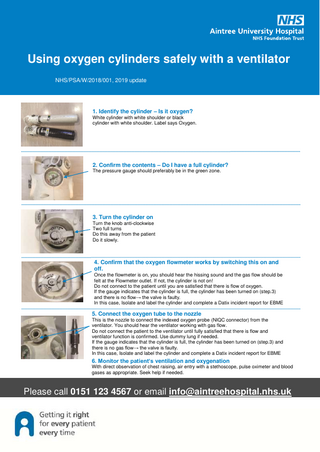Aintree University Hospital Guide
1 Page

Preview
Page 1
Using oxygen cylinders safely with a ventilator NHS/PSA/W/2018/001, 2019 update
1. Identify the cylinder – Is it oxygen? White cylinder with white shoulder or black cylinder with white shoulder. Label says Oxygen.
2. Confirm the contents – Do I have a full cylinder? The pressure gauge should preferably be in the green zone.
3. Turn the cylinder on Turn the knob anti-clockwise Two full turns Do this away from the patient Do it slowly.
4. Confirm that the oxygen flowmeter works by switching this on and off. Once the flowmeter is on, you should hear the hissing sound and the gas flow should be felt at the Flowmeter outlet. If not, the cylinder is not on! Do not connect to the patient until you are satisfied that there is flow of oxygen. If the gauge indicates that the cylinder is full, the cylinder has been turned on (step.3) and there is no flow→ the valve is faulty. In this case, Isolate and label the cylinder and complete a Datix incident report for EBME
5. Connect the oxygen tube to the nozzle This is the nozzle to connect the indexed oxygen probe (NIQC connector) from the ventilator. You should hear the ventilator working with gas flow. Do not connect the patient to the ventilator until fully satisfied that there is flow and ventilator function is confirmed. Use dummy lung if needed. If the gauge indicates that the cylinder is full, the cylinder has been turned on (step.3) and there is no gas flow→ the valve is faulty. In this case, Isolate and label the cylinder and complete a Datix incident report for EBME
6. Monitor the patient’s ventilation and oxygenation With direct observation of chest raising, air entry with a stethoscope, pulse oximeter and blood gases as appropriate. Seek help if needed.
Please call 0151 123 4567 or email [email protected]